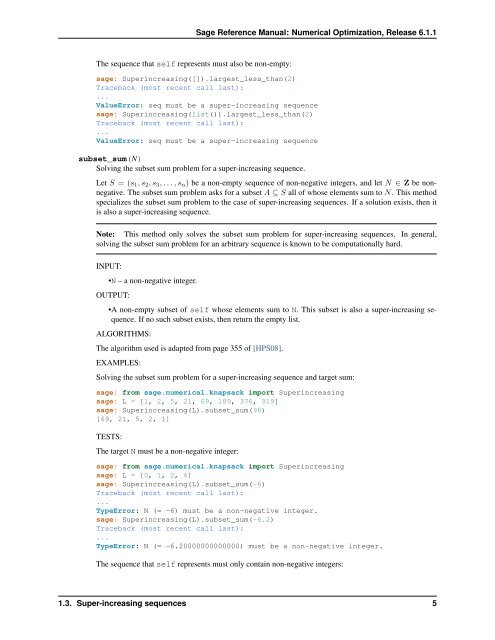Sage Reference Manual: Numerical Optimization - Mirrors
Sage Reference Manual: Numerical Optimization - Mirrors
Sage Reference Manual: Numerical Optimization - Mirrors
You also want an ePaper? Increase the reach of your titles
YUMPU automatically turns print PDFs into web optimized ePapers that Google loves.
<strong>Sage</strong> <strong>Reference</strong> <strong>Manual</strong>: <strong>Numerical</strong> <strong>Optimization</strong>, Release 6.1.1<br />
The sequence that self represents must also be non-empty:<br />
sage: Superincreasing([]).largest_less_than(2)<br />
Traceback (most recent call last):<br />
...<br />
ValueError: seq must be a super-increasing sequence<br />
sage: Superincreasing(list()).largest_less_than(2)<br />
Traceback (most recent call last):<br />
...<br />
ValueError: seq must be a super-increasing sequence<br />
subset_sum(N)<br />
Solving the subset sum problem for a super-increasing sequence.<br />
Let S = (s 1 , s 2 , s 3 , . . . , s n ) be a non-empty sequence of non-negative integers, and let N ∈ Z be nonnegative.<br />
The subset sum problem asks for a subset A ⊆ S all of whose elements sum to N. This method<br />
specializes the subset sum problem to the case of super-increasing sequences. If a solution exists, then it<br />
is also a super-increasing sequence.<br />
Note: This method only solves the subset sum problem for super-increasing sequences. In general,<br />
solving the subset sum problem for an arbitrary sequence is known to be computationally hard.<br />
INPUT:<br />
•N – a non-negative integer.<br />
OUTPUT:<br />
•A non-empty subset of self whose elements sum to N. This subset is also a super-increasing sequence.<br />
If no such subset exists, then return the empty list.<br />
ALGORITHMS:<br />
The algorithm used is adapted from page 355 of [HPS08].<br />
EXAMPLES:<br />
Solving the subset sum problem for a super-increasing sequence and target sum:<br />
sage: from sage.numerical.knapsack import Superincreasing<br />
sage: L = [1, 2, 5, 21, 69, 189, 376, 919]<br />
sage: Superincreasing(L).subset_sum(98)<br />
[69, 21, 5, 2, 1]<br />
TESTS:<br />
The target N must be a non-negative integer:<br />
sage: from sage.numerical.knapsack import Superincreasing<br />
sage: L = [0, 1, 2, 4]<br />
sage: Superincreasing(L).subset_sum(-6)<br />
Traceback (most recent call last):<br />
...<br />
TypeError: N (= -6) must be a non-negative integer.<br />
sage: Superincreasing(L).subset_sum(-6.2)<br />
Traceback (most recent call last):<br />
...<br />
TypeError: N (= -6.20000000000000) must be a non-negative integer.<br />
The sequence that self represents must only contain non-negative integers:<br />
1.3. Super-increasing sequences 5
















